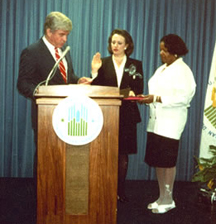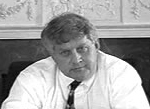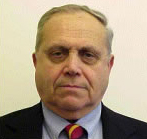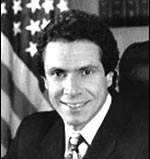By Lucy Komisar
Aug 30, 2006 [Part 2]
(See Part 1 The scandal that taints Andrew Cuomo.)
On September 12th, a primary will choose the Democratic candidate for New York Attorney General. The front runner is Andrew Cuomo.
Cuomo seeks to succeed Eliot Spitzer, who made a national reputation by targeting corrupt Wall Street and corporate officials. Spitzer has been publicly denounced by his targets, including former AIG chairman Maurice Hank Greenberg, accused of cooking the books to present a fraudulent picture of his company’s financial position.

In December, Cuomo’s father, former Governor Mario Cuomo, announced he was helping to launch a public relations campaign on Greenberg’s behalf. Would Attorney General Andrew Cuomo go after Greenberg? Or other Wall Street and corporate miscreants? A look at his tenure as Bill Clinton’s Secretary of Housing and Urban Development raises serious doubts.
When Cuomo became HUD Secretary in 1997, he axed a federal program that had saved the US $2.2 billion between 1994 and 1997 and reinstituted a system that lost the government money while earning billions for favored friends.
He used the power of his office to target a former HUD official who had assisted his predecessor in operating the successful program. A HUD legal vendetta destroyed the official’s company before the Justice Department finally admitted there was no case and dropped it.
This is Part 2 of Fees for Our Friends. [See part one]

Catherine Austin Fitts had been Assistant Secretary of Housing from 1989 until 1991 under Jack Kemp in the first Bush administration. In charge of the Federal Housing Administration, she discovered that the FHA mortgage system, which insured mortgages to help American families get cheaper homes and apartments, was being abused to create large profits for the political friends of HUD’s managers. She saw evidence of widespread fraud. Kemp fired her when she tried to reform the system.
After Bill Clinton was elected President, Fitts and her Washington D.C. company, Hamilton Securities, were hired by the new HUD Secretary Henry Cisneros to deal with the problem of billions of dollars in defaulted mortgages.
Hamilton developed a program to sell defaulted FHA mortgages instead of foreclosing them. Instead of forcing American families out of their homes, HUD would sell the mortgages, and the buyers –from big investment companies to small real estate agencies — would generally work out payment schedules for owners, who could then remain in their homes.
The first big acution was the SouthEast loan sale of multi-family properties in spring 1995. Before it happened, Hamilton had spent months preventing a Maryland mortgage servicer named John Ervin from being hired as a contractor on the SouthEast sale, because it believed he wasn’t qualified. He was furious, because the sale was going to sell the mortgages he had been servicing for HUD. Servicing involved collecting mortgage payments and performing other management duties.
The loan sale program was extremely successful. However, the companies that had been making big profits from the old system didn’t like that. [See more details in Part 1.]
The QUI TAM
At the end of Cisneros’s tenure, a stealth attack of judicial complaints and investigations was launched against Hamilton and Fitts that tied her up in court battles for years and destroyed the company. The assault was promoted by the HUD Inspector General and by the Washington D.C. US Attorney and the Civil Division of the US Justice Department.

In June 1996, a qui tam was filed by Ervin & Associates of Bethesda, Md., owned by John Ervin, accusing Hamilton and two successful bidders, Goldman, Sachs & Company and PNC (BlackRock), of illegal bidding activities.
A qui tam, or whistleblower suit, is a legal action under the Federal False Claims Act by which a member of the public charges that an individual or company has cheated the government. If the charge is proved, the private party gets 15 to 30 percent of the judgment.
By law, a qui tam authorized a 60-day investigation which can be extended only if the investigating agency can show a legitimate reason. The qui tam is filed secretly, but upon receipt of a subpoena, the accused must be informed that he or she is a target.
Ervin had been getting some $7 million a year in HUD contracts to service defaulted mortgages and manage foreclosed properties. In the wake of HUD’s loan sale program, his business dropped. In a sealed qui tam complaint, Ervin alleged that Hamilton Securities had provided insider information and rigged bids for Wall Street companies including Goldman Sachs, BlackRock Capital and Ocwen Financial Corporation. He said it was steering loan sales to them.
The Department of Justice delegated the qui tam investigation to the HUD Inspector General, which is expressly prohibited under the statute, since the agency would be investigating itself. Also in violation of the law, the HUD IG did not inform Hamilton it was the subject of an investigation related to a qui tam. Hamilton would not be informed of the nature of the charges against it for four years, even though there were press leaks accusing Hamilton of breaking the law.
In fact, design books published on the Internet had made the procedures for loan sales at issue in the lawsuit more transparent than they had been for previous sales. Dozens of HUD employees, including representatives of the Offices of General Counsel and Inspector General, had been involved i carrying out and reviewing the process. There were charges that Hamilton leaked the amount of bids received by bidders to other bidders during the bid day. This would have had to occur in a sealed hotel room in the presence of HUD employees.

Hamilton wasn’t Ervin’s only target. He had been fired by HUD for not properly dealing with a financial services contract. According to the General Accounting Office, Ervin filed 37 bid protests concerning HUD contracting actions.
In June 1996, he filed a Bivens lawsuit against HUD, the Small Business Administration, HUD Secretary Cisneros and other HUD officials charging them with contract favoritism, insider trading and bid-rigging on behalf of certain Wall Street insiders. Bivens is a suit charging personal corruption by a government official, meaning that he or she is not charged as a government employee and has to pay legal expenses.
In August, he amended the suit to add Helen Dunlap, who ran the loan sales program, and others who he said were part of a conspiracy. Phone and email attempts to reach Ervin to discuss this story and see evidence for his charges were unavailing. His attorney, Wayne Travell of Leach Travell, Vienna, Va., said, “He’s not interested in talking.”
Under the law, if a qui tam is under seal, it’s against the law to tell anybody about it. But, Fitts said, “Ervin took the Bivens documents, which contained charges against Hamilton but did not name Hamilton as a defendant, and sent them to Congress and reporters. Then the HUD IG’s office could leak and say this is all true. If the Bivens lawsuit tracks the qui tam, and the IG’s office is willing to leak, they have you in a vise. You can’t know the allegations against you and you do not have a forum in which you can address them. But they’re free to market them widely.”
She said, “In July (1996), the leaks began. HUD launched a concerted smear campaign.” She believed that HUD officials were telling reporters that Hamilton was guilty of a crime, even though at that time Hamilton was guilty of a crime, even though at that time Hamilton had received no notice of charges. Their anonymous charges would be repeated by reporters for major media who never cited evidence.
Fitts had lunch with Edward Pound of U.S. News and World Report in the summer of 1996. She said he told her, “I have it on the highest levels from the IG’s office that they have irrefutable evidence of you being guilty of criminal things.” Fitts inquired, “Where is the evidence?” In a phone interview, Pound recalled the lunch, but said, “I don’t think she’s characterized what I’m saying precisely.” He declined to say if he got such information from the HUD IG.
But a few months later, Pound wrote in the magazine: In one case, a senior HUD employee says, Dunlap and another agency official ‘pressured’ a small company to retain Hamilton. The firm, Williams, Adley & Col, paid Fitts’s company $6.6 million but denies it was forced to hire her firm. That was one of the allegations that went to trial, but no HUD employee came forward with evidence.”
Pound also wrote: “Ervin says that HUD, in collusion with Hamilton, ‘stacked the deck against small investors,’ structuring the note sales so that the ‘big boys’ on Wall Street would win most of the business.” He cited as examples Goldman Sachs & Co., ‘a very large contributor’ to the Democratic Party, and BlackRock Capital Finance LP, a respected financial powerhouse. Goldman and BlackRock deny any impropriety.
Pound cited no evidence then and declines to provide it now. In fact, if Pound understood anything about the program, he knew that the computer system did quite the opposite, allowing small players as well as big ones to bid.
Fitts’s lawyer wondered later in a letter to HUD OIG attorney Judith Hetherton how Pound could have quoted from a 1993 Hamilton document, part of a bid proposal, which Hamilton had not given to reporters, but which had been provided in confidence to the HUD Inspector General on demand of a subpoena.
On August 6, 1996, Hamilton received the first of many subpoenas in which became years of subpoena warfare. After the first subpoena, Fitts said, she called Susan Gaffney, the HUD Inspector General, and asked if she was going to release the positive audit on the program conducted by the OIG field office in Denver. But Gaffney sat on the audit. She has retired and could not be located for comment.
That year, Cindy Ecker at the HUD Denver IG’s office headed an audit of the loan sales program. After she collected the data, she told loan sales managers that they had done a terrific job and that she was going to write a glowing report. Fitts expected the audit to be issued in August or September. But it didn’t appear. Fitts later found out that Ecker had refused to change her favorable audit and, at the request of the IG, to be critical of the loan sales program.
Fitts’s attorney later got an affidavit from Ecker to the effect that the audit came to the conclusion that the loan sale program was a tremendously successful example of government re-engineering, which was providing considerable benefits for taxpayers. Ecker said that, The Hamilton employees working on the loan sale program appeared to be very honest, intelligent, and dedicated to helping HUD re-engineer itself through the loan sale program. But she said that OIG Headquartes began to interfere with the audit, that Ms. Hetherton or members of her team insisted that we should find evidence of bid-rigging or other allegations raised by Ervin & Associates. Ecker Affidavit
Hetherton declined to discuss this or other instances of her involvement in the case. She is now an attorney at the Office of Bar Counsel, District of Columbia Bar, which investigates unethical behavior by attorneys.
Ecker said, “Despite the [Washington IG] investigation team’s insistence, the audit team found no evidence of wrongdoing on Hamilton’s part or by any other company or individual associated with the program. We specifically found no evidence of bid-rigging, fraud or corruption.” She said the field office objected to headquarters’ interference and that the matter contributed to her decision to leave the government.
Cisneros resigned in January 1997 and was replaced by Andrew Cuomo. Cuomo, who had branded himself as a leader in Vice-President Al Gore’s re-engineering government movement, abolished Hamilton’s loan sales program and reverted to foreclosing single-family homes and selling them. Families were re-engineered right onto the street. HUD put out big contracts to help manage the growing inventory.
The qui tam lawsuit had been filed with Federal District Court for the District of Columbia and assigned to Judge Charles Richey. The record indicates he was not going to extend the seal which kept the lawsuit secret unless the Justice Department came up with evidence of wrong-doing. Then Richey died suddenly.

In early 1997, Ervin’s qui tam was turned over to Federal District Judge Stanley Sporkin, former General Counsel of the Central Intelligence Agency.
Under the law, if the party accused of wrong-doing in a qui tam is subpoenaed, that party must be informed that he or she is the target of a qui tam, even though the complaint is still under seal. In Fitts’s case, the Justice Department and Judge Sporkin took the position that the Justice Department could ignore this disclosure provision by delegating the subpoena issuance to HUD’s Office of the Inspector General. Sporkin ignored the statute’s prohibition of delegation of the investigation, saying that Gaffney had independent investigatory authority.
In a hearing closed to Fitts, revealed by transcripts years later, Sporkin noted that the content of Ervin’s qui tam was the same as the Bivens lawsuit. He suggested that two lawsuits be consolidated under one judge. Justice Department attorneys told Sporkin that they couldn’t consolidate, because that would prevent them from taking opposite positions in the two cases. The Department of Justice argued in open court for years in the Bivens case that Ervin’s charges of corruption in the loan sales program were without merit. During the same years, in qui tam closed hearings, Justice took the opposite position, insisting that there was criminality. It was unable to produce any evidence, but kept asserting, “Give us another extension. There’s terrible wrong-doing here.”
The lead supervising attorney was Frank Hunger, head of the Justice Department’s civil division and Al Gore’s brother-in-law. Cuomo was known to be close to Gore.
In October 1997, Cuomo fired Hamilton. He announced to the press that this was just one case in a campaign of zero tolerance for waste, fraud and abuse at HUD.

The reason for the firing given to Hamilton was a computer glitch that Hamilton had ordered AT&T to fix. AT&T (now Lucent) had assured Hamilton that it could mathematically approximate the program in a way that would obtain within one dollar the same result as a reprogramming. It was wrong.
Then AT&T failed to fix the error a second time, because the technician who was supposed to do it had a heart attack and was transferred when he returned to work. The malfunction caused two loan sales to make $342.8 million when they might have made $346.6 million.
Hamilton reported the events to Assistant Secretary Nicolas Retsinas and the FHA Comptroller, who informed the Acting General Counsel. Retsinas confirmed that.
Hamilton had a best efforts deal with HUD in its advisory contract, not an underwriting relationship. In that case, an advisor is paid a fee and does not share in either the risk of a wrong decision or benefit from an excellent one. That is, it didn’t make a commission on profits, and under its contract it wasn’t obligated to not make any mistakes. In fact, if the computer glitch had been a failure to perform, it would have had to give back around $80,000 under the breach clause. Cuomo decided that Hamilton should be penalized for potential opportunity costs.
Fitts explained, Cash was not lost. If we had not had the glitch and we had chosen other bids and they had all closed with no hitch, then we could have made that much more money. Some bids normally fail to close, so what was lost was the opportunity to make more profit, maybe. HUD was saying in court that Hamilton’s contract was a flat fee contract advice that penalized Hamilton if it turned out there was any circumstance under which more proceeds could have been earned. HUD argued, in effect, that Hamilton had all the downside and none of the upside. Sporkin apparently didn’t understand how transactions of this type work, or didn’t care.
HUD withheld $2.1 million due Hamilton for work performed under its contract and invoiced for work done since 1994. Fitts filed a legal motion in Federal District Court for a temporary restraining order to stop HUD’s withholding of Hamilton’s monies. The case was assigned to Judge Sporkin, who would not grant the order.
Cuomo cancelled the Hamilton/AT&T optimized auctions of FHA mortgages. His reason, ironically, was that HUD could not do the loan sales without Hamilton! Even that was not true: HUD’s three other financial advisors had been trained and worked on HUD loan sales with Hamilton. HUD owned all the design books for the sales, which made it easy for a qualified firm to carry out the operation.
Cuomo reinstated the old HUD cash-cow-for-political-friends system. Homes were foreclosed, suspicious mortgages torn up, and the U.S. Treasury got back 50 percent or less than they had gotten under the loan sales.
Repeated requests to Cuomo’s press secretary for an interview about this story were unavailing.
Hamilton would be subject to eighteen audits and investigations and seven years of litigation, all in violation of qui tam legal protections. Anonymous HUD officials would smear the company without ever offering proof of wrong-doing, and their charges would be repeated by reporters for major media such as The Washington Times and U.S. News and World Report who didn’t cite evidence.

Fitts would read about a subpoena in The Washington Times before Hamilton got it. The Times on October 24, 1997, ran an article headlined, HUD orders fired firm to surrender documents. The subpoena to which the article referred was served on Hamilton just before 5 pm on the day the article was published. That meant the newspaper had been informed of the subpoena the day before.
Fitts’s lawyer wrote Hetherton, “We can think of no possible source for such information other than HUD’s Office of the Inspector General. The lawyer asked to know which HUD individuals knew of the subpoena and if Hetherton was taking steps to determine who had leaked the information. There was no answer.
In spite of the qui tam disclosure rule, Hamilton would not be informed that it was named as a defendant in the action for one-and-a-half years, not until December 1997, when its attorneys had a conversation with lawyers in the Justice Department. Even then, Hamilton was not informed of the identity of the complainant or the exact nature of the charges.
The complaint was not unsealed for three-and-a-half years, not until April 2000. And not till December 2000 were the secret court transcripts opened, and then some transcripts were missing. It was the first time Fitts could prove that Ervin had filed the qui tam. It was still another two years before Ervin and the government were required to put forward evidence supporting their claims and before Hamilton and its attorneys could refute them in court.
Fitts said that she and those helping her lived with years of physical harassment and surveillance. She said, “This included break-ins; stalking; having house guests followed; friends, colleagues and family warned not to associate with me; dead animals left on the doormat and worse. My uncle was called by the HUD IG’s office, which tried to persuade him I was a criminal. He got a knock on the door at night at his home, and there were four HUD IG and FBI agents to deliver a subpoena. He was shaken. Our in-house counsel had her tires slashed. Checks sent to her didn’t arrive.”
Another blow came when Hamilton was informed in the fall of 1997 by its errors and omissions insurer, an affiliate of AIG — headed by Mario Cuomo’s friend Hank Greenberg — that the insurer would not pay Hamilton’s legal defense costs, because it believed that Hamilton was guilty of fraud, not covered by the policy. Hamilton finally got AIG to start funding some of the defense in March 1998, but the insurance company insisted on firing Hamilton’s lawyers and putting in attorneys who had no previous experience with Hamilton, its HUD contracts and the case.
HUD refused to process the payment of money due Hamilton from previously closed-out contracts. At the same time that HUD was cutting off Hamiton’s revenues, it required the company to perform time-consuming and costly work to close out other contracts. There was a full court press. The IRS put the Hamilton 40lK under audit in 1997, so Fitts could not use it as collateral to finance required closeout expenses. Finally, for closeout and attorney’s fees, she busted her personal $500,000 401K, thereby incurring $225,000 in taxes and penalties.
She said, “I think it was all intentional, a coordinated plan.” She said, “Under the law, in theory, before irreparable harm is done, you get to know your accuser and can refute the allegations. This was engineered so they could destroy Hamilton’s revenues and my assets before I could address the allegations.”
HUD IG attorney Hetherton convinced Judge Sporkin to approve the appointment of a special master so that all of Hamilton’s files and records would be put under court control. The special master oversaw a raid on Hamilton’s office at 7 Dupont Circle in March 1998 by a team of HUD and FBI agents who seized all documents, computer files and back-up tapes and, according to Fitts, ravaged proprietary programs to an unrecoverable state.
Hamilton had been saving all documents and had not thrown out weeks of trash because of ambiguities in subpoenas. Trash was piled high in bags in the office stairwells and basement. The property manager let HUD and FBI agents into the basement of the building, where the agents found empty totems — containers for materials designated to be shredded. The manager saw government agents bring the totems upstairs and fill them with trash and Hamilton documents.
Then the manager saw a woman named Judy, who identified herself as being from the OIG’s office, take photos of the totems. He later swore, “I told her that the totems had not been filed yesterday, like they were then, when I first showed them to the FBI agent.” According to Fitts, the OIOG official, apparently Judith Hetherton, told him, “Shut up, this is none of your business.”
The property manager called Fitts to relate the story. Fitts said, “He told us, ‘They’re trying to frame you. I want to give an affidavit.’ “His affidavit describing the incident was turned over to the special master. [property manager’s affidavit]
Meanwhile, Hetherton wrote a letter to Fitts and represented to the court that Hamilton was attempting to destroy evidence. In fact, shredding the accounting files would have have destroyed anything essential, because they were print-outs of what was in Hamilton’s computerized accounting systems, copies of which the IG had seized. As indicated earlier, Hetherton declined to discuss the Hamilton case.
Fitts had been suspicious that mortgages securities were being issued for phantom properties, or at least in amounts in excess of underlying collateral. She explained that an informant had told her, “They take 20 houses in a neighborhood and issue ten mortgages on each house. Then they issue mortgage-back securities with 200 mortgages. They churn defaults, one of the mortgages on each house, to generate the money to pay for debt service for mortgages on 200 houses. You have all these collateralized mortgages outstanding, paying debt service not with legitimate property cash flows but with FHA insurance proceeds. You default the mortgage, the lender makes an insurance claim against FHA, and that gives you cash. You turn the mortgages into the FHA and it gives you use that to pay the debt service on the pool. It was a Ponzi scheme.”
Hamilton had developed what it called Community Wizard software to map neighborhoods and compare the trading value of mortgage-backed securities with street level data on the houses serving as collateral for the mortgages. Fitts said, “It was clear they wanted to steal and destroy our data bases and tools. It would have exposed the churn.” Years after the Hamilton office was raided and the documents finally turned back from court control, Fitts got back the program documentation books, but many CDs with the most valuable software were gone.
Fitts filed complaints against the HUD IG, supported by the Cindy Ecker and property manager affidavits, with President Clinton’s Council on Integrity and Efficiency, but the Council declined to consider them.
Though Ervin had been fired, his contract cancelled for failure to perform, and though he had filed a Bivens lawsuit against both HUD and its officials, in October 1998, HUD under Andrew Cuomo engineered a two-year, no-bid $825,000 contract for Ervin’s company through Ginnie Mae, the Government National Mortgage Association. It was a substantial amount of money for a small operation qualified to do only low level functions.
Then HUD did a deal with Ervin, settling his lawsuits against HUD for $2 million. As part of the settlement, the government officials accused in the Bivens action who were also named in the qui tam were let off the hook, even though, if the charges against Hamilton being levied in the name of the government by Ervin in the qui tam were true, such officials would also have been guilty. Fitts wondered if Cuomo was financing the litigation against Hamilton through the back door.
Helen Dunlap, who ran the loan sales program, said she thought Ervin was being paid to stop his suit, because the work of the department was being blocked by John’s consistent attempts to disrupt. He had poured molasses into the procurement process at HUD and would have significantly impacted on Andrew’s ability to get things done. She added, “John has a pattern. This was not his first or second or third lawsuit gumming up the works to where somebody settles.” The reason for settlement was the consequences of what were literally a FOIA [Freedom of Information Act request] and a protest a day. According to this view, Cuomo chose to give in to blackmail.
Hamilton sued Ervin in June 1999 for tortuous interference with Hamilton’s HUD contract. The qui tam and Hamilton’s case were consolidated by Sporkin at Ervin’s request. The effect was to prevent any hearing of Hamilton’s evidence against Ervin and any legal discovery of Ervin by Hamilton and to deny Hamilton a jury trial.
Meanwhile, court filings later revealed that Justice and HUD had provided Ervin with information that he used to file an amended complaint in 1999. Fitts said: “He would file FOIAs and get information from them. He would go on a fishing expedition when under the law he’s not allowed to do it. He repackaged the information and made more allegations that made it possible to continue the fishing expedition. They [Ervin and HUD] were feeding off each other.”
It was legal, but it was not the way the qui tam law was designed to be used. Given the detailed information the government already had about Hamilton’s operations, there was no way Ervin could have been telling it something it didn’t already know. It was an error of the court not to rule that Ervin was not an original source.
Hamilton’s lawyer Michael McManus commented, “Qui tams in general are being abused by the Justice Department. They use it as a money-making operation. We’re in tight budgetary times. The government sees this as an opportunity to make money without having to spend a lot of their own resources to do it. And for any money that flows back into the Treasury, somebody gets a nice pat on the back.”
In August 1999, the FBI, to which the Justice Department had referred the criminal part of the investigation, documented that it had found no concerns, suspicions, or evidence of collusion involving the HUD loan sales. Even losing bidders did not attribute their lack of success to collusion or other bidders having inside information. But Hamilton was not informed of this finding until after the court documents were unsealed the next year. It learned it not in the unsealed records, but through a subsequent FOIA request of FBI documents.
Fitts said, “Finally, in September 1999, I was invited by the Department of Justice and the HUD IG to a meeting. It was the most infuriating five hours of my life. No one there had a shred of evidence of any wrong-doing. They hadn’t bothered to read the material on the loan sales. The guys from the HUD IG’s office were too embarrassed to look at me; they were looking at their feet. Here I was, a person who had worked to stop corruption in government, and the HUD IG was trying to destroy me.”
Anthony Alexis, the Assistant US Attorney, said to McManus, “I’m recommending this be shut down.”
Fitts called a lawyer who had dealt successfully with HUD corruption and said, “The qui tam will be unsealed; it’s over.” He replied, “No. Alexis will recommend it; then he will be moved off the case. He may be demoted as punishment for not getting you. A new guy will be moved on, and it will start all over.”
After Alexis made the recommendation, he was removed from the case. In September 1999, Assistant US Attorney Rudy Contreras was assigned to continue the investigation. Alexis did not deny to this reporter that he had recommended the case be dropped, but he declined to elaborate about that or his change of assignment, and he referred questions to a Justice Department public relations official.
So, Fitts and her team set to work launching a website in early 2000 to post legal documentation and summaries of what was happening. They posted hundreds of documents from the twelve pieces of litigation. Sporkin had extended the seal of the legal 60-day investigation into 1400 days: a four-year assault. But after Fitts started posting the case documents online, the qui tam was suddenly unsealed, and the case began to unravel.
In April 2000, the Justice Department closed its investigation and notified the court that it declined to participate in Ervin’s qui tam. That indicated that Justice did not believe in the alleged evidence. It was months more before Federal District Judge Louis F. Oberdorfer, who replaced Sporkin on the case when the latter left the bench, unsealed the transcripts.
Investigations had been carried out by the Justice Department’s Civil, Criminal and Anti-trust divisions, the FBI, and the US Attorney’s Office in Washington. All the government investigators except for the Inspector General at HUD found that there was no proof of wrong-doing. The HUD IG announced it would continue the investigation. And Cuomo still refused to pay Hamilton the $2.1 million due it.
Cuomo resigned as HUD Secretary in 2001 when George W. Bush took office. Throughout Cuomo’s tenure, HUD’s Single-Family Mortgage Insurance Program remained on the annual General Accounting Office (GAO) list of federal programs vulnerable to waste, fraud, abuse and mismanagement.
The qui tam trial finally began in 2004. Now the Republicans were back in power. Hamilton got information on discovery that showed that the Justice Department knew all along there was no case. The Department had paid an expert to look at the loan sales, and he had informed his client that Ervin‘s analysis in the qui tam complaint was invalid, that Hamilton‘s numbers were correct and that there had been no damages to HUD.
Fitts said, “It turned out they never had evidence of wrongdoing the whole way along, and they knew it. The whole thing was a scam. Why did the government spend millions of dollars over nine years and never stop when it had multiple chances to dismiss?” Why did Justice want to target Hamilton?
Fitts points out that HUD cases prosecuted by the Justice Department were generating revenues from civil penalties. Ervin would say in a deposition that he referred $40 million of civil money penalty opportunities to Justice. Fitts said, “He got contracts from HUD as part of his mortgage servicing contract, but he actually used them to troll for enforcement opportunities for Justice. A developer told me that they would come in and say, “We‘re going to audit you, but we‘ll go away if you pay us $25,000.‘ It‘s greenmail. ˜We‘ll settle for $25,000.‘ The guy knows he‘s innocent, but it would cost him more to fight. The loan sales were hurting their [Justice‘s and HUD OIG‘s] business.”
Fitts had used her own money and liquidated Hamilton’s assets to pay for compliance with court demands; to acquire legal representation for the qui tam litigation; and to seek recovery of the $2.1 million due Hamilton. She estimates the costs at $6 million.
In 2004, Hamilton won a Court of Claims suit that it had filed against HUD in 1998 for payment of its outstanding advisory fees. The judge ruled that the $3.8 million “loss” claimed by HUD/Ervin in the qui tam case was not a sufficient justification to withhold payment and that in any case, HUD’s contract did not obligate Hamilton to deliver an optimization program, much less deliver perfect loan sales results. HUD and Justice appealed the case with permission from the Solicitor General‘s Office.
Fitts noted, “They [the government, in the qui tam case] took the position that a contractor was liable for [lost] opportunity costs. Under that rationale, AMS and banks running HUD accounts are responsible for up to $59 billion missing from the government. It‘s a hell of a precedent!” [See part one.]
After the Court of Claims found in her favor, Fitts went into Louis Oberdorfer‘s Federal District Court in the qui tam case. Before trial started, all but five of the allegations were dropped or found baseless.
Judge Oberdorfer found in Ervin‘s favor with respect to the alleged opportunity loss of $1.5 million (half a percent of loan sale proceeds) on one of the two loan sales involving the computer glitch that Hamilton had reported to the government. The judge ruled that Ervin was the original source of the evidence presented even though he had learned about it from public records a year after Hamilton‘s report of the glitch to HUD and had amended his case to include the information.
The judge found no liability for the original error, only for its repetition in the second HUD loan sale which he considered recklessness on Hamilton’s part. He decided this although undisputed evidence showed that the repetition of the glitch was the fault of Lucent/Bell Labs, Hamilton’s subcontractor, which failed to correct the error as ordered, not Hamilton, and though there had been no material harm to the government.
The judge ruled in Hamilton‘s favor on the other counts. The charges of contract fraud, bid rigging and leaking inside information had proved unfounded.
The case was on appeal, when Hamilton‘s insurance company, AIG, said it wanted to settle. In the past, Fitts had refused, arguing that Ervin had no evidence. But the case was at a stalemate, with opposing decisions in the Court of Claims and U.S. District Court, and when the government is supporting one side in a civil action, it has deeper pockets than any private citizen. Besides, she thought that rising inflation would wipe out a bigger settlement that came later. She agreed to a resolution in early 2006.
AIG paid the government and Ervin‘s insurance company and the government paid Hamilton the money it owed, but after the costs of fighting the case, Fitts got pennies on the dollar. She got millions in insider knowledge.


I first heard about Catherine Austin Fitts on the Coast to Coast radio program some time ago.
Reading your report (or article) here, in light of the recent Fannie Mae and Freddie Mae meltdowns and the bailout mania (AiG, CitiGroup, soon to be car companies and others), it appears to me that our current economic mess was setup long ago by those in power. Those who completely violated the public trust, betraying their oaths of office (for those that swore such) for the sake of enriching themselves (and their friends) and enhancing their careers (and their friends). I have nothing but contempt for those involved in the smear of Catherine because, had what she discovered been exposed, the public trust would have been more than well served.
Seems to me that “the government” is being run solely for the aggrandizement of those running it and their families, friends and chums. Our forefathers would be revolting in light of such depth of corruption from a government supposedly run “by and for the people”.
Thanks for your article, I hope others take note of this particular case (and related items to it) and do what they can to help end this massive corruption.
Now Cuomo wants to be Gov. of NY, it will be interesting to see if any of this resurfaces. Do we even dare to wonder how deep this rabbit hole runs?
Pingback: Fees for Our Friends: The Scandal that Taints Andrew Cuomo | The Komisar Scoop
Pingback: Unpacking Astonishing Financial Fraud with Lucy Komisar – The Komisar Scoop
Pingback: Fees for Our Friends: The Scandal that Taints Andrew Cuomo – The Komisar Scoop